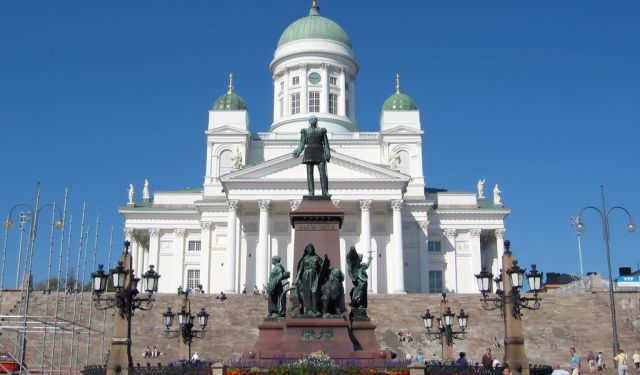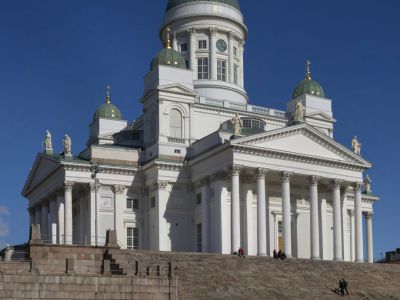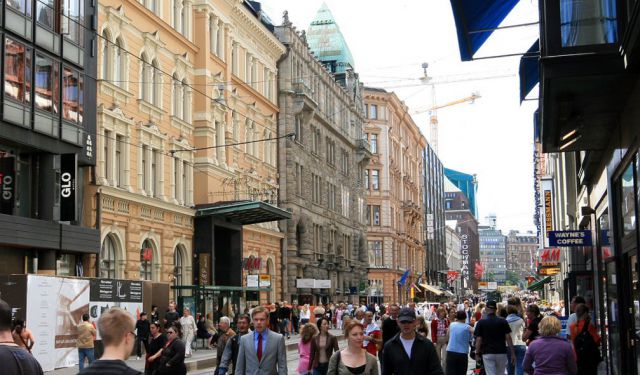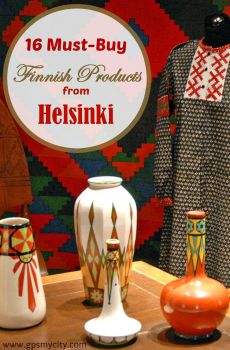
Helsinki's Historical Churches (Self Guided), Helsinki
Because of Finland's former affiliations with neighboring Sweden and Russia, it's no wonder that the religious tapestry of Helsinki is dominated by Lutheran and Orthodox churches. Nonetheless, there are also some beautiful architectural expressions of other Christian denominations like Anglican and Catholic to be found in the city, each holding a special place in its religious narrative.
Among the most notable local churches is the oldest Orthodox temple in the capital, the Holy Trinity Church, dating back to the first half of the 19th century.
Another one closely associated with Russia is the Helsinki Cathedral. A true icon of the city, this magnificent structure dominates Senate Square with its elegant white dome and grand staircase. This neoclassical sanctuary is a popular landmark and a main place of worship for the local Evangelical Lutheran community.
For those interested in Orthodox ecclesiastical architecture, the Uspenski Cathedral is a must-visit. Perched atop a hill, this striking red-brick cathedral was completed in the 1860s and boasts intricate Eastern Orthodox design elements.
The German Church also adds to the diversity of Helsinki's religious heritage. This beautiful Gothic Revival sanctuary showcases a unique blend of imposing exterior and rather intimate interior.
One more Gothic Revival gem is Saint John's Church. Surrounded by lush greenery, it's a rather tranquil place to visit.
Finally, the Helsinki Old Church stands as a symbol of Lutheran tradition. This church was built in the neoclassical style in the 1820s.
Over the years, faith has found diverse and beautiful expressions in Helsinki. Delving into the city's world of Christian history and architecture promises a serene and culturally enriching experience. To explore the spiritual richness of Finland's capital, take this self-guided walking tour.
Among the most notable local churches is the oldest Orthodox temple in the capital, the Holy Trinity Church, dating back to the first half of the 19th century.
Another one closely associated with Russia is the Helsinki Cathedral. A true icon of the city, this magnificent structure dominates Senate Square with its elegant white dome and grand staircase. This neoclassical sanctuary is a popular landmark and a main place of worship for the local Evangelical Lutheran community.
For those interested in Orthodox ecclesiastical architecture, the Uspenski Cathedral is a must-visit. Perched atop a hill, this striking red-brick cathedral was completed in the 1860s and boasts intricate Eastern Orthodox design elements.
The German Church also adds to the diversity of Helsinki's religious heritage. This beautiful Gothic Revival sanctuary showcases a unique blend of imposing exterior and rather intimate interior.
One more Gothic Revival gem is Saint John's Church. Surrounded by lush greenery, it's a rather tranquil place to visit.
Finally, the Helsinki Old Church stands as a symbol of Lutheran tradition. This church was built in the neoclassical style in the 1820s.
Over the years, faith has found diverse and beautiful expressions in Helsinki. Delving into the city's world of Christian history and architecture promises a serene and culturally enriching experience. To explore the spiritual richness of Finland's capital, take this self-guided walking tour.
How it works: Download the app "GPSmyCity: Walks in 1K+ Cities" from Apple App Store or Google Play Store to your mobile phone or tablet. The app turns your mobile device into a personal tour guide and its built-in GPS navigation functions guide you from one tour stop to next. The app works offline, so no data plan is needed when traveling abroad.
Helsinki's Historical Churches Map
Guide Name: Helsinki's Historical Churches
Guide Location: Finland » Helsinki (See other walking tours in Helsinki)
Guide Type: Self-guided Walking Tour (Sightseeing)
# of Attractions: 6
Tour Duration: 2 Hour(s)
Travel Distance: 3.0 Km or 1.9 Miles
Author: naomi
Sight(s) Featured in This Guide:
Guide Location: Finland » Helsinki (See other walking tours in Helsinki)
Guide Type: Self-guided Walking Tour (Sightseeing)
# of Attractions: 6
Tour Duration: 2 Hour(s)
Travel Distance: 3.0 Km or 1.9 Miles
Author: naomi
Sight(s) Featured in This Guide:
- Holy Trinity Church
- Helsinki Cathedral
- Uspenski Cathedral
- German Church
- St. John's Church
- Helsinki Old Church
1) Holy Trinity Church
The Holy Trinity church holds the distinction of being the oldest Orthodox Church in the city of Helsinki. It is located in the Kruununkaka District of town, on the corner of Unioninkatu and Rauhankatu Streets. It is also one of the bigger tourist draws among churches in town. It also happens to be located next to the Helsinki Cathedral.
It was constructed in 1826. The architect was the German architect Carl Engel, who also designed Helsinki Cathedral and some other churches in the area. It was built in a neoclassical style of architecture. The church’s beautiful yellow exterior, which is trimmed in white, is quite lovely. This helps to accentuate the bell tower, and give it a very clean look.
It is the inside of the church that is the best part though. You will be amazed at the gold and silver in setting for the furniture, trimming, pictures, icons etc. This is set against the scarlet colored flooring and pristine white ceilings.
Services are held here each Sunday in Slavic and Finnish.
It was constructed in 1826. The architect was the German architect Carl Engel, who also designed Helsinki Cathedral and some other churches in the area. It was built in a neoclassical style of architecture. The church’s beautiful yellow exterior, which is trimmed in white, is quite lovely. This helps to accentuate the bell tower, and give it a very clean look.
It is the inside of the church that is the best part though. You will be amazed at the gold and silver in setting for the furniture, trimming, pictures, icons etc. This is set against the scarlet colored flooring and pristine white ceilings.
Services are held here each Sunday in Slavic and Finnish.
2) Helsinki Cathedral (must see)
Helsinki Cathedral is an important symbol of Finnish culture and architecture, situated in the heart of Helsinki's Kruununhaka neighborhood on Senate Square. This impressive building serves as the main Lutheran cathedral for the Diocese of Helsinki and has a rich history dating back to the early 19th century. Initially built between 1830 and 1852, the cathedral was dedicated to the Grand Duke of Finland, Tsar Nicholas I, and was known as Saint Nicholas's Church until Finland gained independence in 1917. Today, it is renowned worldwide as one of Finland's most significant historical landmarks.
Designed by Carl Ludvig Engel in the Neoclassical style, Helsinki Cathedral features a distinctive green dome surrounded by four smaller domes, creating a striking silhouette against the city skyline. Engel intended the cathedral to be the focal point of his design for Senate Square, with other structures complementing its grandeur. The cathedral's architectural plan, based on a Greek cross, emphasizes symmetry with colonnades and pediments adorning each arm, though Engel's original vision for additional columns at the entrance was never realized.
Built on the site of the earlier Ulrika Eleonora Church from the 18th century, Helsinki Cathedral's foundation has historical significance. Construction was funded by a decree from Alexander I, tying its origins to Helsinki's designation as the nation's capital in 1812. While Engel passed away before its completion, Ernst Lohrmann, his successor, made further contributions to the design, including the addition of four small domes and a bell tower. Notable zinc statues of the Twelve Apostles, crafted by renowned artists of the time, adorn the roofline.
Throughout its existence, Helsinki Cathedral has undergone renovations and restorations, including the conversion of its crypt into a functional space for exhibitions and events beyond religious ceremonies. It remains an important center for worship, hosting regular services and special occasions like weddings. With half a million visitors in 2018 alone, it is a popular tourist destination, embodying Finnish culture and spirituality through its historical significance, architectural grandeur, and active community involvement.
Tips:
Plenty of steps to get to the cathedral's main entrance (no handrails, so be prepared). There are some wheelchair ramps if needed.
Also worth a visit is an atypical café right under the cathedral (Cafe Krypta). The entrance is at the back of Kirkkokatu Street or via elevator from the cathedral. Friendly staff, delicious pastries, and inexpensive coffee.
Designed by Carl Ludvig Engel in the Neoclassical style, Helsinki Cathedral features a distinctive green dome surrounded by four smaller domes, creating a striking silhouette against the city skyline. Engel intended the cathedral to be the focal point of his design for Senate Square, with other structures complementing its grandeur. The cathedral's architectural plan, based on a Greek cross, emphasizes symmetry with colonnades and pediments adorning each arm, though Engel's original vision for additional columns at the entrance was never realized.
Built on the site of the earlier Ulrika Eleonora Church from the 18th century, Helsinki Cathedral's foundation has historical significance. Construction was funded by a decree from Alexander I, tying its origins to Helsinki's designation as the nation's capital in 1812. While Engel passed away before its completion, Ernst Lohrmann, his successor, made further contributions to the design, including the addition of four small domes and a bell tower. Notable zinc statues of the Twelve Apostles, crafted by renowned artists of the time, adorn the roofline.
Throughout its existence, Helsinki Cathedral has undergone renovations and restorations, including the conversion of its crypt into a functional space for exhibitions and events beyond religious ceremonies. It remains an important center for worship, hosting regular services and special occasions like weddings. With half a million visitors in 2018 alone, it is a popular tourist destination, embodying Finnish culture and spirituality through its historical significance, architectural grandeur, and active community involvement.
Tips:
Plenty of steps to get to the cathedral's main entrance (no handrails, so be prepared). There are some wheelchair ramps if needed.
Also worth a visit is an atypical café right under the cathedral (Cafe Krypta). The entrance is at the back of Kirkkokatu Street or via elevator from the cathedral. Friendly staff, delicious pastries, and inexpensive coffee.
3) Uspenski Cathedral (must see)
Part of the Eastern Orthodox Church, the Upenski Cathedral is the official seat of the bishop of Helsinki for that faith tradition. It is dedicated to the Dormition of Theotokos (The Bearer of God, or Mary). In fact, the name of the church itself is derived from the old Slavic word for Dormition.
The building was finished in 1868 and took a total of six years to complete. The well known Russian architect Alexey Gomostaev designed the structure. Sadly, it was not completed in his lifetime.
There is a crypt chapel that is built into the building complex. It was named after one of the old Vicars of the church, Alexander Hotovitzky. He served the local parish in the early 1900s.
There are several very beautiful icons on display in this cathedral. They also happen to be quite valuable as art antiquities. In fact, two of them had been stolen from the church in the last several years, with only one having been (remarkably) recovered. Consequently, glass protection covers had to be added, but this will not ruin your chance to appreciate the icons.
Tips:
- The climb up involves quite a number of stairs. Go up there at sunset. You'll get stunning photos of the cityscape with the sun setting just behind the Lutheran Cathedral.
- The rocks right in front of the church are popular place to sit on together with friends enjoying the view. Just watch out – they are steep!
The building was finished in 1868 and took a total of six years to complete. The well known Russian architect Alexey Gomostaev designed the structure. Sadly, it was not completed in his lifetime.
There is a crypt chapel that is built into the building complex. It was named after one of the old Vicars of the church, Alexander Hotovitzky. He served the local parish in the early 1900s.
There are several very beautiful icons on display in this cathedral. They also happen to be quite valuable as art antiquities. In fact, two of them had been stolen from the church in the last several years, with only one having been (remarkably) recovered. Consequently, glass protection covers had to be added, but this will not ruin your chance to appreciate the icons.
Tips:
- The climb up involves quite a number of stairs. Go up there at sunset. You'll get stunning photos of the cityscape with the sun setting just behind the Lutheran Cathedral.
- The rocks right in front of the church are popular place to sit on together with friends enjoying the view. Just watch out – they are steep!
4) German Church
The German Church is an important part of the community. This beautiful old church was built in 1864 and its Neo-Gothic style is a favorite of newly weds in Finland. One look at this picturesque venue makes it easy to see why it is so popular.
The Front entrance to the church is breathtakingly beautiful. The brick work is amazing and the door is framed by six large gothic windows in the transept. There is a large spire that was added in 1897 which just adds to the majesty of the building. The entire building underwent a massive refurbishing in 2001, and the results are wonderful.
For such a large exterior, the sanctuary is amazingly intimate. The muted color scheme aids in this illusion. The altar is exquisitely carved with great detail and so elegantly frames a painting of Christ at the Crucifixion. The pews are very simple so they do not distract from the elegance of the altar.
Services are held here on Sunday mornings at 11:00 and the services are in German. Services are also held on occasion at 23:00 as well as special activities around church holy days, so be sure to check the schedule when visiting.
The Front entrance to the church is breathtakingly beautiful. The brick work is amazing and the door is framed by six large gothic windows in the transept. There is a large spire that was added in 1897 which just adds to the majesty of the building. The entire building underwent a massive refurbishing in 2001, and the results are wonderful.
For such a large exterior, the sanctuary is amazingly intimate. The muted color scheme aids in this illusion. The altar is exquisitely carved with great detail and so elegantly frames a painting of Christ at the Crucifixion. The pews are very simple so they do not distract from the elegance of the altar.
Services are held here on Sunday mornings at 11:00 and the services are in German. Services are also held on occasion at 23:00 as well as special activities around church holy days, so be sure to check the schedule when visiting.
5) St. John's Church
Saint John's Church in Helsinki is a significant architectural landmark designed by the Swedish architect Adolf Melander. Constructed between 1888 and 1891 in the Gothic Revival style, it's not only impressive in its size, being able to seat 2,600 people, but also holds great historical and cultural importance as the largest stone church in Finland. It was the third Lutheran church built in Helsinki and remains the largest to this day.
Situated on a hill in the Ullanlinna district, Saint John's Church has a rich tradition associated with Midsummer celebrations, known locally as "John's Day." Its twin towers, reaching 74 meters (243 feet) high, dominate the skyline. Inside, the church boasts excellent acoustics, making it a popular venue for concerts and events as well as regular services.
A notable artistic feature is the altarpiece titled "A Divine Revelation," depicting Saul's conversion, painted by Eero Järnefelt, who has familial ties to Jean Sibelius. This adds a spiritual and artistic dimension to the church's interior.
To maintain its beauty and structural integrity, the church has undergone necessary renovations. A recent project focused on repairing and renewing its gargoyles, which had deteriorated due to Helsinki's maritime climate.
The church is also famous for its impressive organ, originally built in 1891 by the German firm Walcker of Ludwigsburg. Over the years, it has undergone expansions and renovations, including enhancements by Oskar Merikanto in 1921 and Christian Scheffler Orgelwerkstatt in 2004-2005. A new English-style shell organ was installed in 2018, further enriching the church's musical heritage.
Situated on a hill in the Ullanlinna district, Saint John's Church has a rich tradition associated with Midsummer celebrations, known locally as "John's Day." Its twin towers, reaching 74 meters (243 feet) high, dominate the skyline. Inside, the church boasts excellent acoustics, making it a popular venue for concerts and events as well as regular services.
A notable artistic feature is the altarpiece titled "A Divine Revelation," depicting Saul's conversion, painted by Eero Järnefelt, who has familial ties to Jean Sibelius. This adds a spiritual and artistic dimension to the church's interior.
To maintain its beauty and structural integrity, the church has undergone necessary renovations. A recent project focused on repairing and renewing its gargoyles, which had deteriorated due to Helsinki's maritime climate.
The church is also famous for its impressive organ, originally built in 1891 by the German firm Walcker of Ludwigsburg. Over the years, it has undergone expansions and renovations, including enhancements by Oskar Merikanto in 1921 and Christian Scheffler Orgelwerkstatt in 2004-2005. A new English-style shell organ was installed in 2018, further enriching the church's musical heritage.
6) Helsinki Old Church
The Old Church has been an integral part of the Helsinki area since 1727. It started in a temporary building that was named the Ulrika Eleonora Church. The local congregation finally outgrew this location, so it became necessary to build a new structure. That building was started in 1826 and was finally completed in 1852.
It is mainly a wooden church built in a neoclassical style of architecture. Some of the material from the original structure was also re-used in this current building. The benches, lighting and the church organ were removed and reset in the current home of the faithful. Over the years, though, the pipe organ was replaced by a 36 stop model in 1869.
The altarpiece is quite beautiful. It is one of the prettiest pieces of religious art to be found in the city. It was done by the Finnish painter Robert Ekman who is best known for his romantic portraits. It was originally intended for the Helsinki Cathedral, but ended up here instead.
The church is located inside a local park that is maintained by the city. Unsurprisingly, the park is called the Old Church Park. It is also referred to by the locals as Plague Park because over a thousand people died of the plague in 1710 are buried right next to the place.
It is mainly a wooden church built in a neoclassical style of architecture. Some of the material from the original structure was also re-used in this current building. The benches, lighting and the church organ were removed and reset in the current home of the faithful. Over the years, though, the pipe organ was replaced by a 36 stop model in 1869.
The altarpiece is quite beautiful. It is one of the prettiest pieces of religious art to be found in the city. It was done by the Finnish painter Robert Ekman who is best known for his romantic portraits. It was originally intended for the Helsinki Cathedral, but ended up here instead.
The church is located inside a local park that is maintained by the city. Unsurprisingly, the park is called the Old Church Park. It is also referred to by the locals as Plague Park because over a thousand people died of the plague in 1710 are buried right next to the place.
Walking Tours in Helsinki, Finland
Create Your Own Walk in Helsinki
Creating your own self-guided walk in Helsinki is easy and fun. Choose the city attractions that you want to see and a walk route map will be created just for you. You can even set your hotel as the start point of the walk.
Seurasaari Island Walking Tour
Seurasaari Island in Helsinki is best known as the home to the popular open-air museum. This venue offers a glimpse into the life of Finland's countryside in various epochs, showcasing old, mainly wooden houses, some of which – once lived in by famous people in Finnish history – were transplanted to the island and thus became part of the museum.
Among the notable attractions here are... view more
Tour Duration: 2 Hour(s)
Travel Distance: 1.6 Km or 1 Miles
Among the notable attractions here are... view more
Tour Duration: 2 Hour(s)
Travel Distance: 1.6 Km or 1 Miles
Finnish Souvenir Shopping Tour
When in Helsinki, souvenir shopping can be an exciting adventure allowing you to bring home a memorable piece of Finland worth having in your household. Depending on your inclinations, these could include sauna bucket and ladle, traditional Finnish music instruments, hand-woven long-tufted rugs (ryija), Finnish vodka made from Arctic-grown berries, or something else.
Those in the know can give... view more
Tour Duration: 1 Hour(s)
Travel Distance: 2.0 Km or 1.2 Miles
Those in the know can give... view more
Tour Duration: 1 Hour(s)
Travel Distance: 2.0 Km or 1.2 Miles
Helsinki Introduction Walking Tour
Helsinki was created as a trading town by Swedish King Gustav I in 1550, but it is believed that Swedish settlers had arrived here in the 1300s. Sometimes called the “Daughter of the Baltic,” Helsinki is a port town through and through. Its close connection to its Baltic neighbors, Sweden and Russia, has shaped its history for better and worse over the last 400 years. Both Finnish and Swedish... view more
Tour Duration: 2 Hour(s)
Travel Distance: 3.1 Km or 1.9 Miles
Tour Duration: 2 Hour(s)
Travel Distance: 3.1 Km or 1.9 Miles
Helsinki's Architectural Jewels
Typified by Nordic minimalism and refinement, the architecture of Helsinki is shaped primarily by the early neoclassical style and a regional form of Art Nouveau called Jugendstil. Still, it is the later work by modernist architect, Alvar Aalto, as well as the thriving contemporary designs deeply rooted in nature and local craft that give Helsinki, as well as Finland in general, their current... view more
Tour Duration: 2 Hour(s)
Travel Distance: 1.9 Km or 1.2 Miles
Tour Duration: 2 Hour(s)
Travel Distance: 1.9 Km or 1.2 Miles
Useful Travel Guides for Planning Your Trip
Finnish Sweets and Pastries
The country of thousands of lakes and the magical homeland of Santa Claus, Finland is also a major producer of quality chocolate and many other sweet delights without which surviving long winter nights in this Nordic part of Europe would have been far too boring. Big on coffee, the Finns love their...
16 Distinctively Finnish Things to Buy in Helsinki
Shopping in Helsinki for an extraordinary range of tasteful and distinctive products is made simple and easy with the creation of a design district in the heart of the city which has many department stores, shopping centers, and boutique shops bunched together. The Finnish capital is a good city for...
The Most Popular Cities
/ view all












